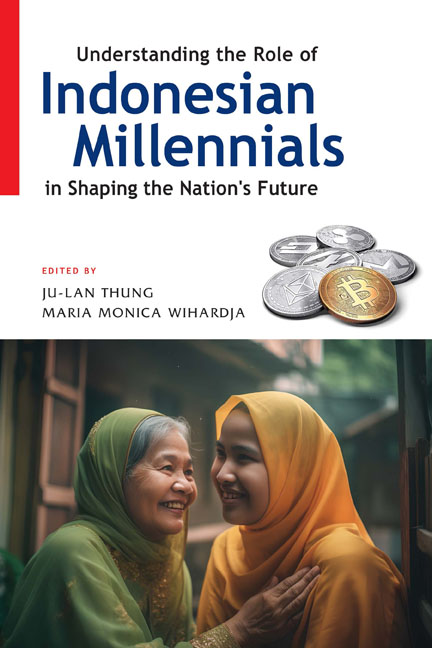Book contents
- Frontmatter
- Contents
- List of Figures
- List of Tables
- List of Annexes and Appendixes
- About the Contributors
- Introduction: Understanding the Role of Indonesian Millennials in Shaping a Nation’s Future
- 1 Generational Differences in Life Course Trajectories of Indonesians in Their Mid-twenties: Comparing Millennials and Older Cohorts
- 2 Millennials and Politics in Indonesia: 2019 and Beyond
- 3 Progressive Yet Powerless: The State of Indonesia’s Progressive Youth Organizations in the Post-Authoritarian Era
- 4 Indonesia’s Millennials and Gen Zs: Are They Financially (Il)literate?
- 5 Digital Competencies of the Millennial Generation in Micro, Small, and Medium Enterprises in West Bandung District
- 6 Millennial Muslims and “Haram Fatwas” on Cryptocurrency in Contemporary Indonesia
- 7 Youth and Religious Disaffiliation: A Study of Indonesian Millennials Learning Buddhism during Spiritual Disruption
- 8 Antagonism and Afterwards: Millennials in Indonesian Participatory Art after Reformasi
- 9 The NFT Phenomenon among Indonesia’s Millennial Artists
- Index
Introduction: Understanding the Role of Indonesian Millennials in Shaping a Nation’s Future
Published online by Cambridge University Press: 13 April 2024
- Frontmatter
- Contents
- List of Figures
- List of Tables
- List of Annexes and Appendixes
- About the Contributors
- Introduction: Understanding the Role of Indonesian Millennials in Shaping a Nation’s Future
- 1 Generational Differences in Life Course Trajectories of Indonesians in Their Mid-twenties: Comparing Millennials and Older Cohorts
- 2 Millennials and Politics in Indonesia: 2019 and Beyond
- 3 Progressive Yet Powerless: The State of Indonesia’s Progressive Youth Organizations in the Post-Authoritarian Era
- 4 Indonesia’s Millennials and Gen Zs: Are They Financially (Il)literate?
- 5 Digital Competencies of the Millennial Generation in Micro, Small, and Medium Enterprises in West Bandung District
- 6 Millennial Muslims and “Haram Fatwas” on Cryptocurrency in Contemporary Indonesia
- 7 Youth and Religious Disaffiliation: A Study of Indonesian Millennials Learning Buddhism during Spiritual Disruption
- 8 Antagonism and Afterwards: Millennials in Indonesian Participatory Art after Reformasi
- 9 The NFT Phenomenon among Indonesia’s Millennial Artists
- Index
Summary
Millennials or Generation Y—those born between 1981 and 1996—represent the population cohort who are moving into the prime of their careers and lives. It is this generation that is being groomed to take up leadership roles in various sectors of society. How millennials mature and develop, the values they hold and the capabilities they acquire will be crucial determinants of the outlook for a nation going forward. Millennials may not be digital natives, but they have grown up amid what is known as the Fourth Industrial Revolution—the current era where virtually every industry is being transformed by the exponential pace of technological change and digitalization. Unprecedented technological changes and what is known as hyper-globalization have caused disruptions to cultural and societal norms. The values and work ethics of millennials are shaped by their exposure to digital social media (Smith and Nichols 2015; Tulgan 2016). These characteristics—their exposure to technology and their world views, among others—place a huge gap between millennials and previous generations. As Hoffman (2017) and Tulgan (2016) have noted, millennials are the most misunderstood among the generations, particularly by their parents’ and grandparents’ generations, the Generation X and baby boomers.
In Indonesia, those from the millennial generation are slated to take up positions as leaders in various important spheres of society—from the political, economic and business spheres to the education, arts and culture sectors. Experiencing the prime of their lives amid the Fourth Industrial Revolution and the COVID-19 pandemic, millennials have acutely experienced disruptions to their family and working lives as well as ways of doing business.
Indonesia's demographic changes call for understanding the intergenerational gap that is at the core of the so-called millennial disruptions. The gap is a complex one—it exists not only between different generations but also between the millennials living in rural areas and those living in urban areas, as well as between rich and poor millennials. Several phenomena might indicate where to look in order to understand what has changed and how such change has disrupted our lives. Firstly, technology has created closer relationships between those separated by distance while making strangers of those living in close proximity to one another. Consequently, family and people-to-people relations have changed to the extent that the well-known solidarity of the Indonesian people, gotong-royong, has been completely redefined by the millennials. Millennials use different tools to empower and help each other.
- Type
- Chapter
- Information
- Publisher: ISEAS–Yusof Ishak InstitutePrint publication year: 2024

